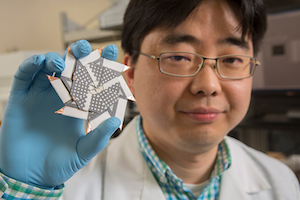The series of small, powerful and inexpensive paper-based “BioBatteries” that developed from a simple origami shape in the lab of Assistant Professor Seokheun “Sean” Choi, PhD—and run on bacteria found in a few drops of dirty water—could transform point-of-care diagnostic testing in remote locations across the globe where medical resources are scarce. Choi’s research is yet another example of the pivotal role higher education plays in developing game-changing ideas for New York state industries. The continuing support Choi and his team of undergraduate and doctoral students receive from the university and from state and national grants to develop this technology has also allowed promising parallel research in bacteria-powered solar cells and spit-fueled paper batteries that cost pennies to produce. All of it could revolutionize how BioBatteries power disposable diagnostic electronics in dangerous or isolated regions of the developing world.
Biobatteries that use common bacteria to conduct electrical current, also known as microbial fuel cells (MFCs), were first developed in the early 20th century. Today, MFCs power electronic devices which require minimal energy and simple biosensors such as those found in disposable pregnancy and HIV tests. Their effectiveness is limited, however, by the low power single cells can generate. Choi and his student team at Binghamton’s Department of Electrical and Computer Engineering have spent the past several years trying to change that. Building on Choi’s initial finding that stringing several biobatteries together made them perform better, the team found that when stacking them on a single sheet of folded paper, power increased exponentially.
In peer-reviewed journals Choi and his research team showed how microbial fuel cells embedded in a paper origami matchbook, and later, pressed into a flat, transforming ninja star, were the most simple, biodegradable and inexpensive ways to generate the kind of electricity needed to power simple and more sophisticated diagnostic biosensors in the field. Compared to traditional batteries, they are not only easy to transport but are also exponentially cheaper to produce.

Choi readily credits his students with solving many developmental roadblocks along the way. Landen Kwan, a former undergraduate student supported through the National Science Foundation’s Research Experiences for Undergraduates program, “substantially contributed to the ninja battery,” Choi says, and his current students continue to innovate.
“My new PhD students, Yang Gao and Maedeh Mohammadifar, have significantly improved the performance of the paper-based disposable bio-batteries through fundamental device breakthroughs. Their latest paper-based biobattery prototype, created from chromatography paper and freeze-dried bacteria, is activated by human saliva. Another milestone in his parallel research included the first micro-scale, self-sustaining, bio-solar cell to generate power for 13 straight days using two types of bacteria.
The university’s resources have played a fundamental role in the depth, breadth and success of Choi’s research. “Binghamton helped me establish my own lab, the Bioelectronics & Microsystem Lab, which has approximately 1,200 square feet of lab space here in the engineering department,” he says. Divided into three sections, the BML features an area dedicated to the handling of bio/chemical material and chemical synthesis; another specifically designed for prototyping; and a third equipped for a variety of specialized testing.
Because of this support, he says, we’re one step closer to providing challenging areas around the world with “a low-cost, disposable, eco-friendly micro-power source that lasts a long time, can be easily integrated into paper-based point-of-care devices, and is activated by one tiny drop of water, blood, sweat or tears” stated Choi.
